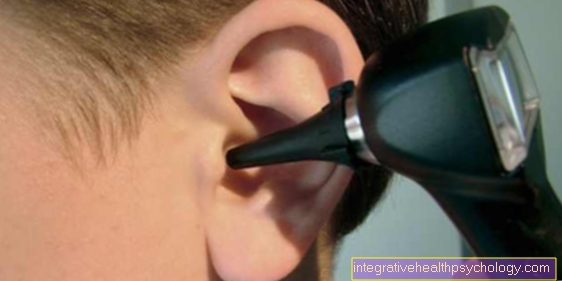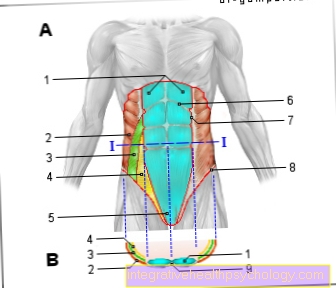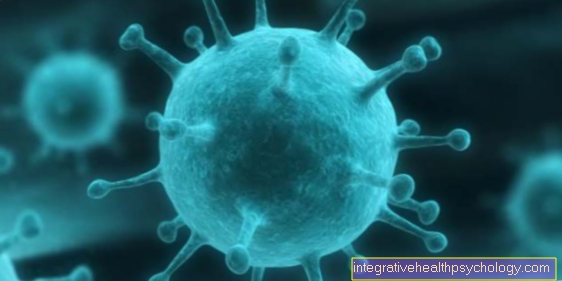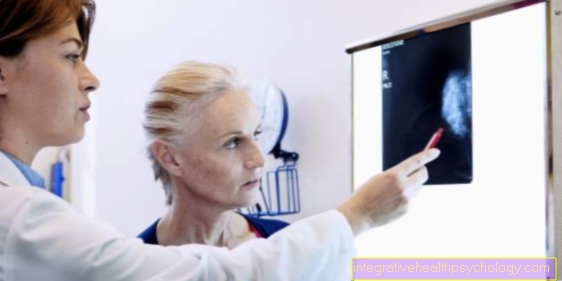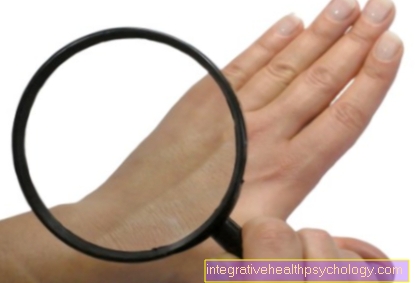Liver disease (surgery)
In the following you will find information on diseases of the liver which are treated surgically.
Synonyms in a broader sense
Medical: hepar
Liver lobes, liver cells, liver cancer, liver cirrhosis, fatty liver
English: liver
Surgical diseases of the liver
In the following you can view the list of all topics that have already appeared on diseases of the liver that can be assigned to the medical field of surgery:
Definition liver
The liver is the central metabolic organ in humans. Their tasks include the food-dependent storage, conversion and release of sugars and fats, the breakdown and elimination of endogenous and medicinal toxins, the formation of most blood proteins and bile, and numerous other tasks.
"Internal organs" illustration
.jpg)
- Thyroid cartilage / larynx
- Windpipe (trachea)
- Heart (cor)
- Stomach (gaster)
- Large intestine (colon)
- Rectum
- Small intestine (ilium, jejunum)
- Liver (hepar)
- Lungs or lungs
Function and anatomy of the liver
The liver is in humans in the right upper abdomen directly under the diaphragm and protrudes with the tip of its left liver lobe to the middle of the upper abdomen.
In adults, the liver weighs about 1400 - 1800 g and is divided into four large lobes: Lobus hepatis dexter - Lobus hepatis sinister - Square lobe - Caudate lobe. The liver can also be in Segments structured. There are 8 liver segments that are of great importance in surgical removal. Segment 1 corresponds to that Caudate lobe. Segments 2-4 correspond to the left lobe of the liver. Segments 5-8 are assigned to the right lobe.
You can find out more about the function and anatomy of the liver under our topic:
- Anatomy liver
Illustration liver
_2.jpg)
- Right lobe of the liver -
Lobus hepatis dexter - Gallbladder duct -
Cystic duct - Gallbladder -
Vesica biliaris - Main bile duct -
Common bile duct - Portal vein -
Vena portae hepatis - Hepatic artery -
Hepatic artery propria - Round liver band -
Ligamentum teres hepatis - Common
Liver bile duct -
Common hepatic duct - Sickle ligament of the liver
Falciform ligament - Left lobe of the liver -
Lobus hepatis sinister - Hepatic veins -
Hepatic veins - Lower vena cava -
Inferior vena cava - Diaphragm - Diaphragm
You can find an overview of all Dr-Gumpert images at: medical illustrations
Liver disease
The following diseases are explained below, which often have a surgical intervention need:
1. Liver tumors
2. Liver abscess
3. Echinococcosis
4. Gallstones
5. Acute liver failure
All diseases of the liver from the area of the Internal medicine can be found under the following link: Liver - internal medicine.
_3.jpg)
Liver tumors
As in Tumors in other organs there are both in the liver benign as well as malignant growths.
The following types of tumors are benign tumors in the liver:
- Hemangioma(Blood sponge in the liver)
- Liver adenoma (benign neoplasm / accumulation of liver cells)
- Focal nodular hyperplasia (benign neoplasm of liver, bile duct and connective tissue cells).
You need to not necessarily removed surgically become. These tumors should only be surgically removed if the symptoms are clear and if they have increased in size.
Kick for about every 10th person Liver cysts (liquid-filled cavities). They are harmless and arise in the womb during the organ development of the fetus. If they don't cause any complaints, they don't need any treatment. In the event of upper abdominal discomfort, bloating, or other symptoms, the liver cysts can be removed by surgical intervention.
Both malignant liver tumors is between the Hepatocellular carcinoma (HCC) and the Cholangiocellular Carcinoma (CCC) differentiated. The first (HCC) is created in the liver itself. The other (CCC) is a malignant cancer in the bile ducts. The number of people affected by hepatocellular carcinoma or cholangiocellular carcinoma has increased significantly in recent years. The reasons for this are viral Inflammation of the liver and the increasing life expectancy of the population.
In addition, you can Daughter tumors (Metastases) from other malignant tumors to implant in the liver. Often these are relocations of the Colon or rectal cancer.
Are liver tumors particularly treacherousbecause they develop symptoms very late and are thus discovered. These include Jaundice, nausea, Weight loss, Water belly, Pain in the upper abdomen. Early detection and surgical removal are of great importance for the probability of survival. In addition, a chemotherapy increase the chances of recovery.
Liver abscess
A abscess is a Accumulation of puscaused by inflammatory processes to a Tissue melting leads and thus forms a pus cavity. The liver abscess turns into a primary and secondary course categorized.
One speaks of a primary course when the abscess has one ascending bacterial settlement in the Gallbladder and the bile ducts arise. The reasons for this can be gallstones or parasites.
The secondary gradients include those that result from an already existing disease arise out. This can include operations on the liver or gallbladder, accidents, chronic inflammation, Diverticulitis, Crohn's disease, Ulcerative colitis or Appendicitis be.
Of the right lobe of the liver is far more likely to suffer from a liver abscess than the left one. In 40% of cases there are several small collections of pus in the liver. Typical signs of liver abscesses are chills, fever, Tenderness in the right upper abdomen, nausea, Vomit. The medical survey, the physical examination, the blood count and the Imaging at. The liver can with liver abscess enlarged and therefore palpable be. In addition, the person concerned expresses pain when pressing on the stomach. In the Blood test Increased inflammation levels can indicate a liver abscess. The imaging procedures like Sonography (Sono), roentgen, Computed Tomography (CT) ultimately confirm the suspicion of a liver abscess.
A liver abscess is first treated with Antibiotics. If the drug does not work, a CT / Sono-controlled Fine needle puncture and an outwardly dissipating wound drainage lead to healing. If conservative therapy fails, a surgical intervention. Here, the abscess alone or a complete segment of liver is removed, the wound is irrigated and wound drainage (a tube that allows the secretion to drain outwards) is inserted.
Echinococcosis
Two types of echinococcosis are known to this day: The alveolar echinococcosis and the cystic echinococcosis. With the alveolar the liver is of Fox tapeworms (Echinococcus multilocularis) infested. The carriers of the parasite are foxes, dogs and cats. The infection must be treated early, otherwise it will destroy the entire structure of the liver. The carrier of cystic echinococcosis is the Dog tapeworm (Echinococcus granulosus). After ingestion, the parasites penetrate the intestinal wall and reach the liver via the portal vein.
If possible, the echinococosis should surgically removed)become. If necessary, healthy liver tissue is also removed (Partial resection of the liver), To play it safe. At the same time, the echinococcosis can with one antiparasitic drugs ("Albendazole").
Gallstones
The gallstones are precipitated salts of the bilethat collect in lumps. They can either be found in the gallbladder, and the disease is called accordingly Cholecystolithiasis referred to, or in the bile ducts (Choleangiolithiasis). There are two types of gallstones: cholesterol stones (approx. 90%) and stones containing bilirubin (approx. 10%).
Risk factorsthat favor gallstones are: the female gender, age:> 40 years, overweight, childbearing age, light skin type.
Typical symptomsGallstones caused by colic stomach pain, nausea, discolored bowel movements, pain in the right and middle upper abdomen radiating to the back and right shoulder, Yellowing of the skin and mucous membranes, with massively congested biliary tract.
To Diagnosis On the one hand, the questioning of the patient is used, who often confirms the symptoms mentioned above. A increased inflammation laboratory can provide clues for gallstones. The imaging ultimately secures the suspected diagnosis. Another method of diagnosis is the endoscopic retrograde cholangiopancreatography (ERCP). Here, a hose with a camera at the tip is placed over the stomach and the duodenum advanced into the bile duct. From there you can examine whether there is a gallstone in it.
Gallstones that do not cause discomfort do not have to be treated. Small stones (<3 cm) can also be used go off by itself. Must have large stones, or small stones that get caught in the bile ducts surgically removed become. Nowadays, the gallbladder is removed with the help of a laparoscopy, a minimally invasive method.
A chronic gallstone disease leads to recurring gallbladder infections. A so-called Porcelain gall bladder can arise from it. The name is appropriate because the calcification of the gallbladder makes it look like porcelain in the ultrasound image. With a porcelain gallbladder, the risk is malignant degeneration increased, which is why the affected person is advised to have an early surgical removal of the gallbladder.
Acute liver failure
As the name suggests, it is a acutely occurring Happened which untreated to death leads. The function of the liver is suddenly disturbed. The clinical picture is caused by viruses or toxins e.g. of the tuber mushroom, Drugs or other chemicals. The patients get typical failure symptoms how Jaundice, Coagulation disorders, drowsiness and coma.
A instant life saving Therapy must be initiated. If possible, the cause must be eliminated. With severe damage to the liver, the only way out is one Liver transplant.



.jpg)


